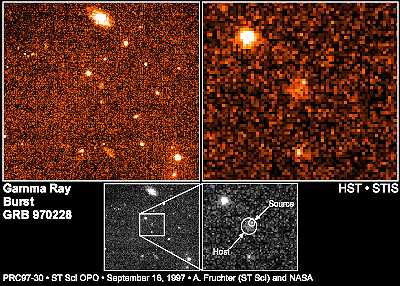

September 16, 1997
Photo No.: STScI-PRC97-30
A Hubble Space Telescope image of the fading fireball from one of the universe's most mysterious phenomena , a gamma-ray burst.
Though the visible component has faded to 1/500th its brightness (27.7 magnitude) from the time it was first discovered by ground based telescopes last March (The actual gamma-ray burst took place on February 28,) , Hubble continues to clearly see the fireball and discriminate a surrounding nebulosity (at 25th magnitude) which is considered a host galaxy.
The continued visibility of the burst, and the rate of its fading , support theories that the light from a gamma-ray burst is an expanding relativistic (moving near the speed of light) fireball, possibly produced by the collison of two dense objects, such as an orbiting pair of neutron stars.
If the burst happened nearby, within our own galaxy, the resulting fireball should have had only enough energy to propel it into space for a month. The fact that this fireball is still visible after six months means the explosion was truly titanic and, to match the observed brightness, must have happened at the vast distances of galaxies. The energy released in a burst, which can last from a fraction of a second to a few hundred seconds, is equal to all of the Sun's energy generated over its 10 billion year lifetime.
The false-color image was taken Sept 5 with the Space Telescope Imaging Spectrograph.
Photo Credit: Andrew Fruchter (STScI), Elena Pian (ITSRE-CNR), and NASA
PRESS RELEASE NO.: STScI-PR97-30
New NASA Hubble Space Telescope observations of the ever-fading fireball from one of the universe's most mysterious phenomena -- a gamma-ray burst -- is reinforcing the emerging view that these titanic explosions happen far away in other galaxies, and so are among the most spectacularly energetic events in the universe.
The most recent finding from observations with Hubble's Space Telescope Imaging Spectrograph (STIS) made on Sept. 5 - nearly six months after the blast - is being reported today at the Fourth Huntsville Symposium on Gamma Ray Bursts, at the Hilton Hotel in Huntsville, Al.
"Hubble is the only telescope capable of continuing to watch the aftermath of this explosion, because it has faded to 1/500th its brightness when first discovered by ground based telescopes last March," says Andrew Fruchter of the Space Telescope Science Institute in Baltimore, Md. "These observations provide an unprecedented opportunity to better understand the catastrophe behind such incredible outbursts."
Hubble's key findings are:
Hubble observations over the past six months show the fireball is fading at a constant rate, as predicted by theory. Eventually, gas plowed in front of the stellar tidal wave should build up enough resistance to bring the fireball to a halt like snow piling up in front of a plow - and it should blink out. But the fact that hasn't happened yet offers more clues to solving the gamma-ray burst mystery.
If the burst happened nearby, the resulting fireball should have had only enough energy to propel it into space for a month or so before "hitting the wall" of accumulated gas and dying out. The fact that this fireball has expanded to gargantuan size, sweeping out a bubble of space one light-year across, means the explosion was truly titanic and, to match the observed brightness, must have happened at the vast distances of galaxies.
When Hubble first acquired the fireball, on March 27 (several weeks after the initial discovery) it was at 26th magnitude. The magnitude scale is used to measure the brightness of objects in space. The lower the magnitude, the brighter the object. The unaided eye can detect objects of the 6th magnitude.
By the Sept. 5 observation, it had faded to 1/5th that brightness to 27.7 magnitude (approximately 1/500,000th) the brightness of the faintest star). The suspected host galaxy has remained at approximately 25th magnitude.
Only Hubble has the resolution and contrast capability to still distinguish the fading fireball from the now brighter host galaxy. The researchers hope for follow-up observations to continue keeping track of the burst's optical counterpart until it fades away.
The research team: Andrew Fruchter (STScI), Elena Pian (ITSR), Steve Thorsett (Princeton), Marco Tavani (Columbia), Mario Livio (STScI), Kailash Sahu (STScI), Filippo Frontera (ITSR), Larry Petro (STScI) and Duccio Macchetto (STScI).
Tammy Jones
Goddard Space Flight Center, Greenbelt, MD
(Phone: 301-286-5566)
Ray Villard
Space Telescope Science Institute, Baltimore, MD
(Phone: 410/338-4514)